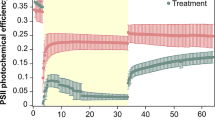Abstract
The genus Catenella is a marine, salt-tolerant, broad, and filamentous red algae, which is widely present on mangroves and marshlands of tropical, subtropical, and temperate regions throughout the world. This review focuses on the various aspects of Catenella sp. including its habitat, variations, morphological characteristics, associations, and uses, emphasizing the ecological and economical importance the genus bears. This study also focuses on the primary and secondary metabolites produced by Catenella sp., its reproductive mechanisms, the possible techniques by which it can be grown under in-vitro conditions, and how it is a unique organism in the living world.



Similar content being viewed by others
References
Aung TH (2018) The genus Catenella Zanardini in Kalegauk Island, Myanmar. Int J Adv Sci Res. 3(5):30–35
Banerjee K, Ghosh R, Homechaudhuri S, Mitra A (2009) Seasonal variation in the biochemical composition of red seaweed (Catenella repens) from Gangetic delta, northeast coast of India. J Earth Syst Sci 118(5):497–505. https://www.ias.ac.in/article/fulltext/jess/118/05/0497-0505
Banerjee K, Mitra A, Mondal K (2010) Cost-effective and eco-friendly shrimp feed from red seaweed Catenella repens (Gigartinales: Rhodophyta). Curr Biotica 8(1):23–43
Bhat SV, Melo JS, Chaugule BB, D’souza SF (2008) Biosorption characteristics of uranium (VI) from aqueous medium onto Catenella repens, a red alga. J Hazard Mater 158(2–3):628–635. https://doi.org/10.1016/j.jhazmat.2008.02.042
Dawes CJ, Mathieson AC (2008) Seaweeds of Florida. University Press of Florida
Hartmann A, Becker K, Karsten U, Remias D, Ganzera M (2015) Analysis of mycosporine-like amino acids in selected algae and cyanobacteria by hydrophilic interaction liquid chromatography and a novel MAA from the red alga Catenella repens. Mar Drugs 13(10):6291–6305
Jofre J, Celis-Plá PS, Figueroa FL, Navarro NP (2020) Seasonal variation of mycosporine-like amino acids in three subantarctic red seaweeds. Mar Drugs 18(2):75
Kaladharan P, Gireesh R (2003) Laboratory culture of Gracilaria spp. and Ulva lactuca in seawater enriched media. Seaweed Res Utiln 25 (1&2):139–142. http://eprints.cmfri.org.in/5952/1/Article_03.pdf
Kleinschmidt R (2009) Uptake and depuration of 131I by the macroalgae Catenella nipae –Potential use as an environmental monitor for radiopharmaceutical waste. Mar Pollut Bull 58(10):1539–1543
Kraft GT (2019) Algae of Australia: Marine benthic algae of north-western Australia 2. Red algae. Phycologia 58(2):225–227. https://doi.org/10.1080/00318884.2018.1551025
Martínez-Daranas B, Suárez AM (2018) An overview of Cuban seagrasses. Bull Mar Sci 94(2):269–282
Narasimha Rao GM, Rangaiah GS, Dora SVVSN (2008) Spore shedding in Catenella impudica from the Godavari estuary at Bhiravapalem India. Algae 23(1):71–74
Pramanick B, Brahmachari K, Kesarwani A, Mahapatra B, Ghosh D, Kumar A (2017) Harnessing marine algae potential in sustainable crop production. Agric Res Technol Open Access J https://doi.org/10.19080/ARTOAJ.2017.05.555655
Prud’Homme van Reine WF, Sluiman HJ, Marchand RP (1983) Red algae found on European salt-marshes II Catenella caespitosa (Rhabdoniaceae). Aquat Bot 15(3):287–298
Rath J, Adhikary SP (2006) Marine macro-algae of Orissa, east coast of India. Algae 21(1):49–59
Runcie JW, Ritchie RJ, Larkum AW (2003) Uptake kinetics and assimilation of inorganic nitrogen by Catenella nipae and Ulva lactuca. Aquat Bot 76(2):155–174
Schneider CW, Wynne MJ (2007) A synoptic review of the classification of red algal genera a half century after Kylin’s “Die Gattungen der Rhodophyceen.” Bot Mar 50:197–249
Sharma N, Jaiswal K, Kumar V, Vlaskin M, Nanda M, Rautela I, Tomar M, Ahmad W (2021) Effect of catalyst and temperature on the quality and productivity of HTL bio-oil from microalgae: a review. Renewe Energy 174:810–822
Soe-Htun U (1998) The seaweed resources of Myanmar. Seaweed resources of the world. Kanakawa International Fisheries Training Center, Japan International Cooperation Agency (JICA), 99–105
Soe-Htun U, Wai MK, Nyunt T, Kyaw SPP, Htay YY, Aye MM, Soe-Htun U, Mu M (2009) Checklist, distribution and potential utilization of marine algae of Myanmar II: Rhodophyta (Red algae). J Myan Acad Arts Sci 7(5):279–305
Tripathi U, Sarada R, Ravishankar GA (2002) Effect of culture conditions on growth of green alga—Haematococcus pluvialis and astaxanthin production. Acta Physiol Plant 24(3):323–329
Tseng CK (1942) Marine algae of Hong Kong, II: the genus Catenella. J Wash Acad Sci 32(5):142–146
Woelkerling WJ (2003) The marine benthic flora of southern Australia Rhodophyta-Part IIID. Ceramiales-Delesseriaceae, Sarcomeniaceae Rhodomelaceae. Phycologia 42(4):448. https://doi.org/10.2216/i0031-8884-42-4-448.1
Yadav N, Singh DP (2021) Photosynthetic efficiency and compositional alterations in microalgae Chlorella vulgaris in response to changes in the pH condition. Vegetos 34(1):119–126. https://doi.org/10.1007/s42535-021-00186-1
Zablackis E, West JA, Liao ML, Bacic A (1993) Reproductive biology and polysaccharide chemistry of the red alga Catenella (Caulacanthaceae, Gigartinales). Bot Mar 36:195–202
Funding
This study is not funded by any government or non-government organizations. Author Arnab Kundu and Bikram Dhara are receiving fellowship from the Dept. of Higher Education, Government of West Bengal, India.
Author information
Authors and Affiliations
Corresponding author
Ethics declarations
Conflict of interest
Authors don’t have any conflict of interest.
Additional information
Publisher's Note
Springer Nature remains neutral with regard to jurisdictional claims in published maps and institutional affiliations.
Rights and permissions
Springer Nature or its licensor holds exclusive rights to this article under a publishing agreement with the author(s) or other rightsholder(s); author self-archiving of the accepted manuscript version of this article is solely governed by the terms of such publishing agreement and applicable law.
About this article
Cite this article
Kundu, A., Paul, S., Biswas, S.J. et al. Nature to lab transfer story of the nutritious alga Catenella: a comprehensive review. Vegetos 36, 743–749 (2023). https://doi.org/10.1007/s42535-022-00475-3
Received:
Revised:
Accepted:
Published:
Issue Date:
DOI: https://doi.org/10.1007/s42535-022-00475-3




